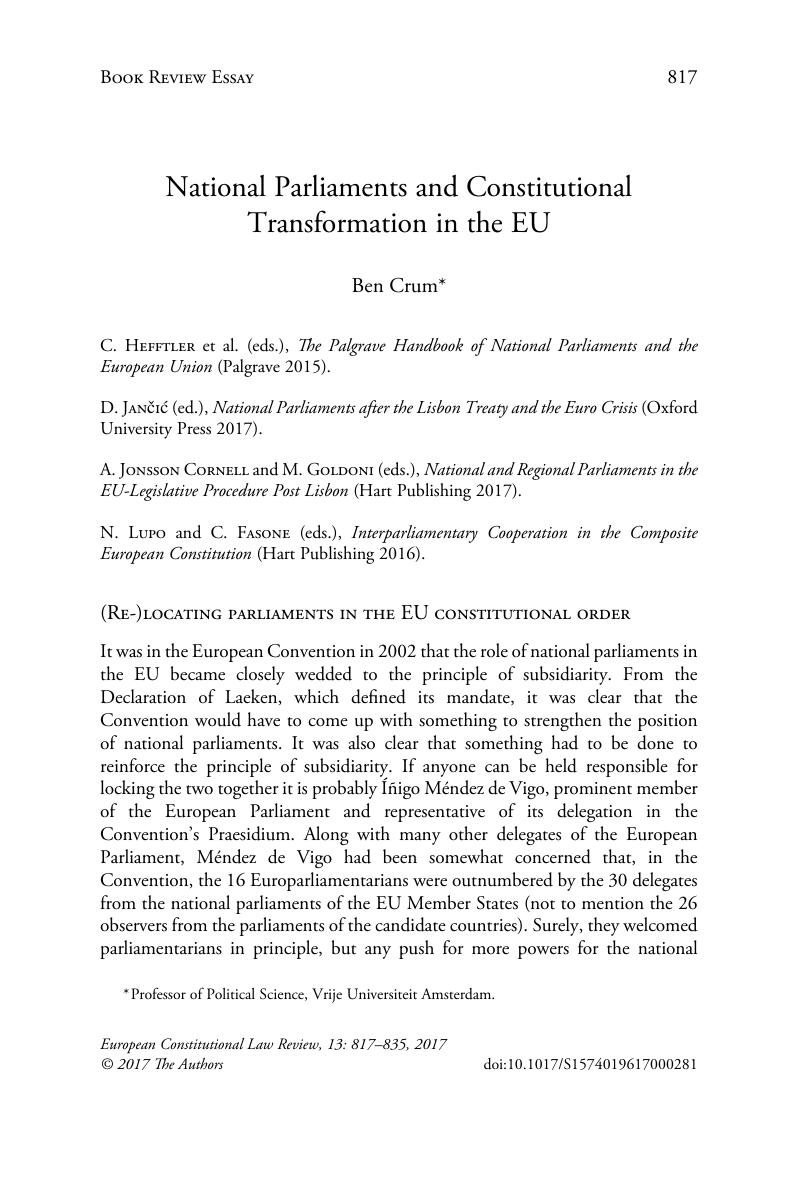Article contents
National Parliaments and Constitutional Transformation in the EU - C. Hefftler et al. (eds.), The Palgrave Handbook of National Parliaments and the European Union (Palgrave 2015). - D. Jančić (ed.), National Parliaments after the Lisbon Treaty and the Euro Crisis (Oxford University Press 2017). - A. Jonsson Cornell and M. Goldoni (eds.), National and Regional Parliaments in the EU-Legislative Procedure Post Lisbon (Hart Publishing 2017). - N. Lupo and C. Fasone (eds.), Interparliamentary Cooperation in the Composite European Constitution (Hart Publishing 2016).
Published online by Cambridge University Press: 04 December 2017
Abstract

- Type
- Book Review Essays
- Information
- Copyright
- Copyright © The Authors 2017
Footnotes
Professor of Political Science, Vrije Universiteit Amsterdam.
References
1 Cf. Groen, A. and Christiansen, T., ‘National Parliaments in the European Union: Conceptual Choices in the European Union’s Constitutional debate’, in C. Hefftler et al. (eds.), The Palgrave Handbook of National Parliaments and the European Union (Palgrave 2015) p. 43 Google Scholar at p. 50 ff.
2 T. Raunio, ‘Much Ado about nothing? National legislatures in the EU constitutional treaty’, 9 European Integration online Papers (2005), <http://eiop.or.at/eiop/texte/2005-009a.htm>, visited 6 October 2017.
3 Buzogány, A., ‘Learning from the Best? Interparliamentary networks and the parliamentary scrutiny of EU decision-making’, in B. Crum and J.E. Fossum (eds.), Practices of Inter-Parliamentary Coordination in International Politics: The European Union and Beyond (ECPR Press 2013) p. 17 Google Scholar.
4 Auel, K., ‘Able and Willing? Early Warning System and Political Dialogue in the Bundestag and Nationalrat’, in A. Jonsson Cornell and M. Goldoni (eds.), National and Regional Parliaments in the EU-Legislative Procedure Post Lisbon (Hart Publishing 2017) p. 291 Google Scholar at p. 311.
5 Cf. Besselink, L., ‘The Place of National Parliaments within the European Constitutional Order’, in N. Lupo and C. Fasone (eds.), Interparliamentary Cooperation in the Composite European Constitution (Hart Publishing 2016) p. 23 Google Scholar at p. 24.
6 K. Auel et al. ‘Fighting Back? And, If So, How? Measuring Parliamentary Strength and Activity in EU Affairs’, in Hefftler et al., supra n. 1, p. 60 at p. 79 (Table 3.5).
7 O. Rozenberg and C. Hefftler, ‘Introduction’, in Hefftler et al., supra n. 1, p. 1.
8 C. Neuhold and J. Smith, ‘Conclusion: From “Latecomers” to “Policy Shapers”? – The role of national parliaments in the “post-Lisbon” Union’, in Hefftler et al., supra n. 1, p. 668 at p. 678 (Table 35.1).
9 A. Jonsson Cornell and M. Goldoni, ‘Introduction’, in Jonsson Cornell and Goldoni, supra n. 3, p. 1 at p. 4.
10 M. Goldoni and A. Jonsson Cornell, ‘The Trajectory of the Early Warning Mechanism’, in Jonsson Cornell and Goldoni supra n. 4, p. 335 at p. 353.
11 Ibid.
12 European Commission, Annual Report 2016 on Relations between the European Commission and National Parliaments, COM(2017) 601 final, Brussels, 30.6.2017.
13 Although the two earlier yellow cards have already been analysed elsewhere in the literature and the one on the posted workers directive is discussed in Jančić, D., ‘EU Law’s Grand Scheme on National Parliaments: The third yellow card on posted workers and the way forward’, in D. Jančić (ed.), National Parliaments after the Lisbon Treaty and the Euro Crisis (Oxford University Press 2017) p. 299 CrossRefGoogle Scholar.
14 Fasone, C. and Lupo, N., ‘Introduction. Parliaments in the composite European constitution’, in N. Lupo and C. Fasone (eds.), Interparliamentary Cooperation in the Composite European Constitution (Hart Publishing 2016) p. 1 Google Scholar at p. 7.
15 Fasone and Lupo, supra n. 14, p. 11.
16 For the sake of disclosure, I should note that the main antagonist here is the concept of an ‘EU Multilevel Parliamentary Field’ as it has been coined by John Erik Fossum and myself: Crum, B. and Fossum, J.E., ‘The Multilevel Parliamentary Field: a framework for theorizing representative democracy in the EU’, 1 European Political Science Review (2009) p. 249 CrossRefGoogle Scholar.
17 C. Fasone, ‘Ruling the (Dis-)Order of Interparliamentary Cooperation? The EU Speakers’ Conference’, in Lupo and Fasone, supra n. 14, p. 269.
18 I. Cooper, ‘The Emerging Order of Interparliamentary Cooperation in the Post-Lisbon EU’, in Jančić, supra n. 13, p. 227 at p. 236ff.
19 Fasone, supra n. 17, p. 288.
20 D. Fromage, ‘Standing Committees in Interparliamentary Cooperation in the Post-Lisbon Era: Towards the end of the European Affairs Committees’ predominance’, in Lupo and Fasone, supra n. 14, p. 113 at p. 129.
21 C. Fasone and N. Lupo, ‘Conclusion. Interparliamentary Cooperation in the Framework of a Euro-national Parliamentary System’, in Lupo and Fasone, supra n. 14, p. 345 at p. 358ff.
22 Auel, supra n. 4, p. 307.
23 Christiansen, T. et al., ‘National Parliaments in the Post-Lisbon European Union: Bureaucratization rather than democratization?’, 12 Comparative European Politics (2014) p. 121 CrossRefGoogle Scholar.
24 J. Tudela cited in D. Fromage, ‘Regional Parliaments and the Early Warning System: An assessment and some suggestions for reform’, in Jonsson Cornell and Goldoni, supra n. 4, p. 117 at p. 133.
25 Cooper, supra n. 18, p. 243ff.
26 A. Merkel, ‘Speech at the opening ceremony of the 61st academic year of the College of Europe in Bruges’, 2 November 2010, <www.coleurope.eu/speeches> visited 6 October 2017; C. Bickerton et al., ‘The New Intergovernmentalism: European Integration in the Post-Maastricht Era’, 53 JCMS (2015) p. 703; Editorial ‘In Search of the Union Method’, 11 EuConst (2015) p. 425.
27 V. Schmidt, ‘The “new” EU Governance: “new” intergovernmentalism, “new” supranationalism plus “new” parliamentarism’, in A. Crespy (ed.), Issue on The EU Economic Governance, Cahiers du Cevipol/Brussels Working Papers, n° 5/2016. (Université Libre de Bruxelles) p. 5.
- 5
- Cited by




